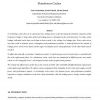Free Online Productivity Tools
i2Speak
i2Symbol
i2OCR
iTex2Img
iWeb2Print
iWeb2Shot
i2Type
iPdf2Split
iPdf2Merge
i2Bopomofo
i2Arabic
i2Style
i2Image
i2PDF
iLatex2Rtf
Sci2ools
121
click to vote
CF
2005
ACM
2005
ACM
Controlling leakage power with the replacement policy in slumberous caches
As technology scales down at an exponential rate, leakage power is fast becoming the dominant component of the total power budget. A large share of the total leakage power is dissipated in the cache hierarchy. To reduce cache leakage, individual cache lines can be kept in drowsy mode, a low voltage, low leakage state. Every cache access may then result in dynamic power consumption and performance penalties. A trade-off between the amount of leakage power saved on one hand, and the impact on dynamic power and performance on the other hand must be reached. To affect this trade-off, we introduce "slumberous caches" in which the power level of cache lines is controlled with the cache replacement policy. In a slumberous cache, cache lines are maintained at different power save modes which we call "tranquility levels", which depend on their order of replacement priorities. We evaluate the effectiveness of this idea in the context of PLRU, LRU and MRR (Modified Random rep...
Applied Computing | Cache | Cache Lines | CF 2005 | Leakage Power |
Related Content
| Added | 13 Oct 2010 |
| Updated | 13 Oct 2010 |
| Type | Conference |
| Year | 2005 |
| Where | CF |
| Authors | Nasir Mohyuddin, Rashed Bhatti, Michel Dubois |
Comments (0)

